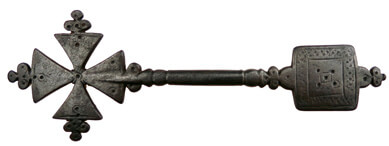
When the Abbey Museum’s Collection was in its infancy, its founder, John S M Ward, bought a number of objects of interest from S. G. Fenton. He was a known reputable dealer in archaeological and ethnographic artefacts and owned an auction house in London. Items were sourced by Fenton from many countries. He traded between 1894 and 1927 under the names of Fenton & Sons, Messrs Fenton Ltd, Fenton & Co, S G Fenton Ltd, and Messrs Fenton Ltd and Fenton & Sons Ltd. During this time his premises were based at Holywell Street, Leicester Square and New Oxford Street in London.
Apparently Fenton often formed a relationship with known seekers of artefacts, with Fenton himself often doing personal deals. The British Museum as well as other UK and international museums acquired various items during this time, as did individual collectors.
At some point, Fenton sold a small decorated metal spatula to Ward. The object was labelled as a bronze spatula for giving the Viaticum used by the Knights of St John. This object has always been seen as a very important one in the collection. It was displayed in the Abbey Folk Park in the 1930s and has been in the medieval display case in the Abbey Museum of Art and Archaeology since its opening. It was also included in the Museum’s publication, Unexpected Treasures.

The object can be described as having a square flat spatula end indented with double incised lines and dots, connected by a cylindrical shaft to a handle end which has a Cross Pattée with trefoil finials, also with indented dots.
When the Collection Management Team was asked to research this object, supporting information of its title and provenance was very hard to find. Firstly we were aware that the object was not bronze, but rather was iron in very good condition, and secondly, we could not find any comparisons.
Research did support the fact that during the Middle Ages the Knights of St John Hospitallers carried a small white silk case for carrying the sacred host and a purple silk case for oil used to anoint the sick. These were for the administration of the Viaticum, which is the final part of the Eucharist or Holy Communion, given to a dying person or one in danger of death as part of the Last Rites. However we could not find any real evidence to support the use of any flat spatula, as most references to the Viaticum depict ordinary spoons. Nor could we find any similar shaped objects that were medieval.
Certainly much of the embellishment on the spatula could be said to depict symbolism that was used in the middle ages. The Cross Pattée was worn by the Knights of St John and later transformed into the Maltese Cross on their arrival in Malta from Rhodes. The four arms of the cross were said to symbolise the four cardinal virtues of prudence and carefulness, justice and doing the right thing by people, temperance and moderate behaviour, and fortitude and courage. The eight points of the Cross were also said to symbolise the qualities described in the Beatitudes as blessed by Jesus in his Sermon on the Mount.
The spatula also has other elements in the design that could be seen as highly symbolic and supporting the connection with the Knights of St. John. The trefoil is said to be symbolic of the Holy Trinity and the central dots are in the form of the five wounds of Christ that were suffered during Crucifixion. These were also depicted on the Jerusalem Cross worn by participants in the Crusades.
Yes, these symbols could support some possible connections, but were they enough to support the object’s title and provenance? Was our artefact an item used sometime between the 13th – 16th centuries by the Knights of St. John as part of the administration of the Viaticum, or was it really something else? Did Fenton have it wrongly labelled?
As further evidence was not forthcoming, we let things sit for a while and puzzled further about it. We did identify some similar shaped objects that were crosses used in processions in Coptic celebrations, but we dismissed these as they were so much larger and also of a later date.
However when searching for something else, someone saw another cross that looked somewhat similar to the one we have. Again it was Coptic and like the processional cross we had found earlier. Although it was still about three times the size of the one we had, were we getting closer? This had us looking again, and below are some examples of what we found: Ethiopian Coptic Hand Crosses, some of which were around the same small size and shape as our object.
Could this be what our little iron spatula really was?

Ethiopian Coptic Hand Crosses usually include three parts: a cross, a handle and a base which is often square. They are smaller than the processional crosses and often carried by priests who used them for blessings. The priest, on meeting a member of his congregation, held out the cross for the parishioner to kiss. Most hand crosses are around 30 cm but some are only around 13 cm like ours.
We think we may now be on the right track. Sadly, in the meantime though, our dear little artefact has been relegated to a drawer until we are sure what it really is. We will keep you posted!
(Research from the Collections Management Team).

